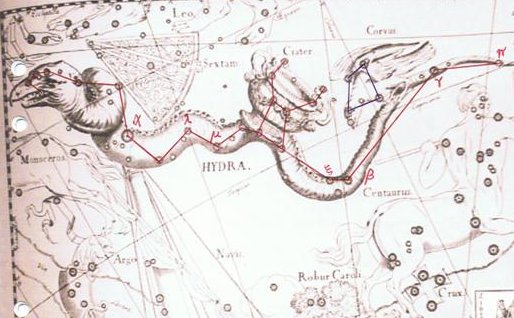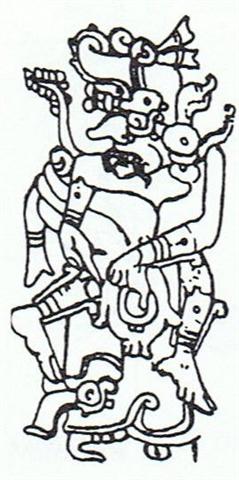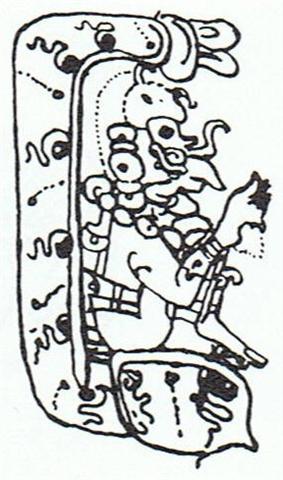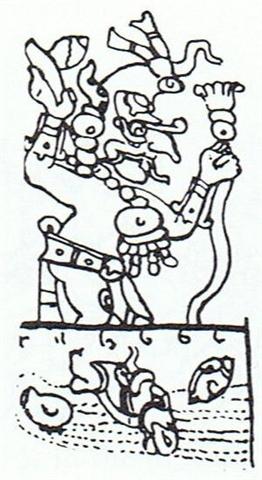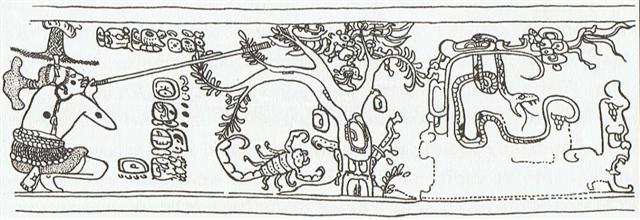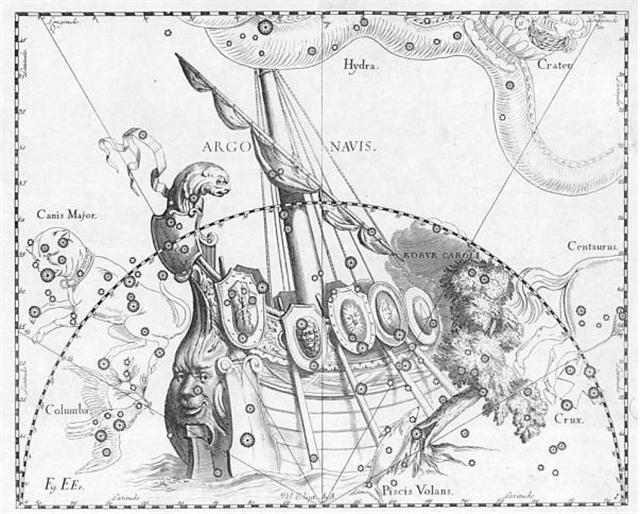123 + twice 27 = 177 (Ga7-8). In the autumn nakshatra sky the Pleiades were seen to be followed by Menkhib (ζ Persei) and after a week came Hyadum II:
From Alcyone up to and including Hyadum I there were 8 nights. From Hyadum II up to and including Haedus II there were 12 days. 8 + 12 = 20. The dates at the time of Bharani are noteworthy. Tamaiti, the Child, at Ga7-11 corresponded to the nakshatra date "April 11 (101) and the preceding glyph was the last of those mysterious 123 which ended here, at heliacal "October 9 (282) = 101 days after heliacal Sirius. This 'child' could refer to the following ika hiku (tail fish) glyph, looking like a shark egg: ... Mermaid's purses (also known as Devil's Purses) are the egg cases of skates, sharks and rays. They are among the common objects which are washed up by the sea. Because they are lightweight, they are often found at the furthest point of the high tide. The eggcases that wash up on beaches are usually empty, the young fish having already hatched out ...
Ga7-10 (179) - 101 = 78 (Ga3-19). Alphard was at the top of the mast of Argo Navis, suggesting a connection between the Hydra and the Sunken Ship:
At the time of Bharani 'the nose of the Lion' (Al Minhar al Asad, κ Leonis) - 12 days after Al Minhar al Shujā (σ at the nose of the Water Serpent) - would have marked day 100 after spring equinox. But at the time of Haedus II it would have been only day 2 * 73 - 80 = 66 after the equinox. And at the time of Hyadum II the day number would have corresponded to a quarter of a circle - possibly suggesting the Lion Sun was beginning with the 2nd quarter of the year, i.e. 157 - 80 = 77 days after MARCH 21. 471 - 157 = 314. The reason why 'the heavenly Ganga' had to be 'brought down' may have been the way in which the Feathered Serpent (carrying rain in the sky) grew shorter over time, was no longer given its proper stretch of time before autumn equinox. The precession forced the normal stars later and later in the year while Sirius (Rigi) went in the opposite direction with the same speed. The constellation of Leo (with the Father of Light, Jupiter) should have arrived before midsummer, but it was pushed ahead, thereby compressing and then ultimately forcing the Hydra (representing the following rain water) down towards the Underworld, the place of the ancients - the Feathered Serpent was no longer given a place in the zodiac:
The feet of the Rain God had produced 14 toe marks in the mud at Gemini. 91 (days from Tejat Posterior up to and including Gienah) - 14 = 77. Possibly the Lion King had become assimilated in the trunk of the Midsummer Tree at Al Minhar al Asad which was rising with the Sun in JUNE 6 (157).
... Most of the people in our van took advantage of the interlude to shop at the nearby stalls set up by highland Maya who had come down to Tikal to take advantage of the steady supply of tourists. However, one of our group, Harriet Gillett, a retired physician and an inveterate bird-watcher, had other interests. She noticed a nearby tree heavy with white blossoms and surrounded by a raucous sphere of birds and bees. She climbed out of the van with her binoculars around her neck, and walked over to take advantage of the unexpected opportunity the morning had provided. Our local guide, Francisco Florián, who knew the forest and its creatures in an unusually intimate way, joined her, explaining that the birds came to the tree only early in the morning. The sounds and the odd sight finally drew my attention and I too disembarked from the van and edged closer to the buzzing center of the action. I stared at the screaming birds as they fought for positions among the flowers and the hovering drone of thousands of bees. How beautiful, I thought, and then my gaze happened to settle on the trunk of the tree. It had thorns and it bulged just above the ground. It was a young ceiba tree. I already knew that the ceiba tree was the model for the sacred World Tree of the Maya, but I had never seen one in flower when I knew what I was looking at. I was really excited because normally you can't see the blossoms even if you're there when the tree is in blossom. The fully mature trees are hundreds of feet high, and the blossoms are very small. 'It's a ceiba', I chirped and began looking for a branch low enough to see one of the blossoms up close. Joyce Livingstone, a retired teacher, did the logical thing. She bent over, picked up a fallen branch, and held it out for me to see. I was too excited and full of myself to listen. She tapped my arm more insistently and still I didn't hear her. Finally, in frustration, she grabbed my wrist and raised her voice. 'Will you look at these?' she said, waving the branch, and finally I did. What I saw stunned me, for in her hand lay a perfect replica of the earflares worn by the Classic Maya kings. Suddenly I understood the full symbolism of so many of the things I had been studying for years. The kings dressed themselves as the Wakah-Chan tree, although at the time I didn't know it was also the Milky Way. The tzuk [partition] head on the trunk of the tree covered their loins. The branches with their white flowers bent down along their thighs, the double-headed ecliptic snake rested in their arms, and the great bird Itzam-Yeh stood on their head. I already knew as I stood under the young tree in Tikal that the kings were the human embodiment of the ceiba as the central axis of the world. As I stood there gazing at the flowers in Joyce's hand, I also learned that the kings embodied the ceiba at the moment it flowers to yield the sak-nik-nal, the 'white flowers', that are the souls of human beings. As the trees flowers to reproduce itself, so the kings flowered to reproduce the world ... The hairy winter Goat should have changed into a Ghost when spring arrived. 192 (July 11) - 91 (364 / 4 = the distance from Tejat Posterior up to and including Gienah) = 101 (the number of Sirius). And the Stag had once upon a time brought the spring 'fire' and would have followed the Horse, but instead the Al Phard was shown impaled as the Star at the top of the mast of Argo Navis:
... Then we learned that five hundred and forty-two days later (1.9.2 in the Maya system), Hun-Nal-Ye 'entered or became the sky' (och ta chan). This 'entering' event occurred on February 5, 3112 B.C. The act of 'entering the sky' is recorded on another extraordinary painted pot. This pot depicts one of the Hero Twins (One-Ahaw in the Classic texts and One-Hunaphu in the K'iche' Popol Vuh) and a great bird who is trying to land in a huge ceiba tree heavy with fruit. This mythical bird is Itzam-Yeh, Classic prototype of Wuqub-Kaqix, 'Seven-Macaw', of Popol Vuh fame.
In that story, in the time before the sky was lifted up to make room for the light, the vainglorious Seven-Macaw imagined himself to be the sun. Offended by his pride, the Hero Twins humbled him by breaking his beautiful shining tooth with a pellet from their blowgun. This pot shows One-Ahaw aiming at the bird as he swoops down to land in his tree. As Itzam-Yeh lands on his perch, the text tells us he is 'entering or becoming the sky'. This particular 'sky-entering' is not the one mentioned in the Palenque text. It is the final event that occurred in the previous creation before the universe was remade. Before the sky could be raised and the real sun revealed in all its splendor, the Hero Twins had to put the false sun, Itzam-Yeh, in his place. If the date on this pot corresponds to that pre-Creation event, as we believe it does, then Itzam-Yeh was defeated in 12.18.4.5.0 1 Ahaw 3 K'ank'in (May 28, 3149 B.C.). After the new universe was finally brought into existence, First Father also entered the sky by landing in the tree, just as Itzam-Yeh did ... The Sunken Ship had no longer a beam pointing towards the receiving Net, because it had moved away from early spring and smashed into the Tree:
|
||||||||||||||||||||||||||||||||||||||||||||||||||||||||||||||||||||||||||||||||||||||||||||||||||||||||||||||||||||||||||||||||||||||||||||||||||||||||||||||||||||||||||||||||||||||||||||||||||||||||||||||||||||||||||||||||||||||||||||||||||||||||||||||||||||||||||||||||||||||||||||||||||||||||||||||||||||||||||||||||||||||||||||||||||||||||||||||||||||||||||||||||||||||||||||||||||||||||||||||




